Arranged in order of prevalence based on checklists submitted by avid birdwatchers on ebird for Alabama, this guide will aid you in recognizing those brown birds that grace your backyard or populate the surrounding woodlands and fields.
Brown Birds in Alabama Throughout the Year:
- Northern Cardinal
- Mourning Dove
- Carolina Wren
- House Finch
- Eastern Towhee
- Brown Thrasher
- Brown-headed Cowbird
- House Sparrow
- Field Sparrow
Brown Birds in Alabama During the Summer:
- Great Crested Flycatcher
- Common Yellowthroat
- Wood Thrush
- Louisiana Waterthrush
Brown Birds in Alabama During the Winter:
- American Robin
- Eastern Phoebe
- Chipping Sparrow
- American Goldfinch
- White-throated Sparrow
- Northern Flicker
- Song Sparrow
- Cedar Waxwing
- Swamp Sparrow
- Savannah Sparrow
- Pine Siskin
- House Wren
- Hermit Thrush
- Purple Finch
- Winter Wren
- Brown Creeper
- White-crowned Sparrow
Brown Birds During Migration in Alabama:
- Rose-breasted Grosbeak
- Swainson’s Thrush
- Marsh Wren
- Northern Waterthrush
Rare or Accidental Species in Alabama:
- Bewick’s Wren
- American Tree Sparrow
- Spotted Towhee
37 Brown Birds In Alabama
1. Northern Cardinal – Female
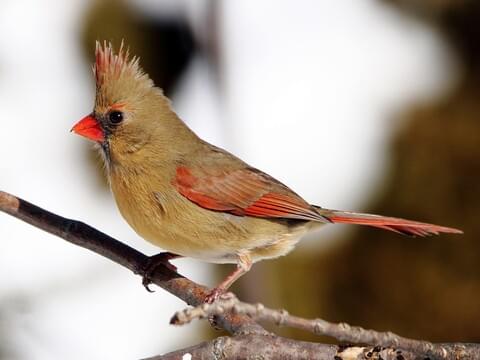
In the state of Alabama, Northern Cardinals are a common sight throughout the year. These beautiful birds make appearances in approximately 65% of summer checklists and 59% of winter checklists submitted by birdwatchers in the state.
Female Northern Cardinals exhibit a touch of flamboyance with their brown plumage, distinctive brown crest, dashes of red accents, and red beaks. However, it is the strikingly vibrant male Northern Cardinal with its red feathers and black facial markings that truly captivates, especially when juxtaposed against a snowy winter backdrop. The males also boast red crests and beaks.
Scientifically known as Cardinalis cardinalis, these birds measure about 8.3 to 9.1 inches (21 to 23 cm) in length, weigh approximately 1.5 to 1.7 ounces (42 to 48 g), and have a wingspan ranging from 9.8 to 12.2 inches (25 to 31 cm).
Northern Cardinals primarily inhabit the eastern half of the United States, extending westward to states like Arizona in the south.
You can encounter Northern Cardinals amidst dense vegetation, where they diligently search for seeds, fruits, and insects. During the breeding season, they sometimes engage in territorial disputes with their own reflections, becoming fixated on defending their territories.
To attract Northern Cardinals to your backyard, provide them with feeders generously stocked with sunflower seeds, peanut hearts, millet, and milo. These birds readily feed from large tube feeders, hoppers, platform feeders, or food scattered on the ground.
2. Mourning Dove

Mourning Doves are abundant in Alabama, making regular appearances throughout the year. They are observed in around 50% of summer checklists and 43% of winter checklists.
These doves possess an elegant demeanor, characterized by small heads, plump bodies, and long tails. Their soft brown feathers are adorned with black spots on the wings. Males tend to be slightly heavier than females.
Scientifically known as Zenaida macroura, Mourning Doves typically measure between 9.1 to 13.4 inches (23 to 34 cm) in length. They weigh approximately 3.0 to 6.0 ounces (96 to 170 g) and boast a wingspan of about 17.7 inches (45 cm). While Mourning Doves are present throughout the lower 48 states year-round, they may migrate from the northern regions of the Midwest and southern Canada after breeding.
You can spot Mourning Doves perched on telephone wires or foraging for seeds on the ground in grasslands, fields, and even residential backyards. They are also commonly found in open areas and along the edges of woodlands.
To attract Mourning Doves to your own backyard, scatter millet on the ground or provide them with platform feeders. They are also known to consume black sunflower seeds, nyjer, cracked corn, and peanut hearts.
3. Carolina Wren
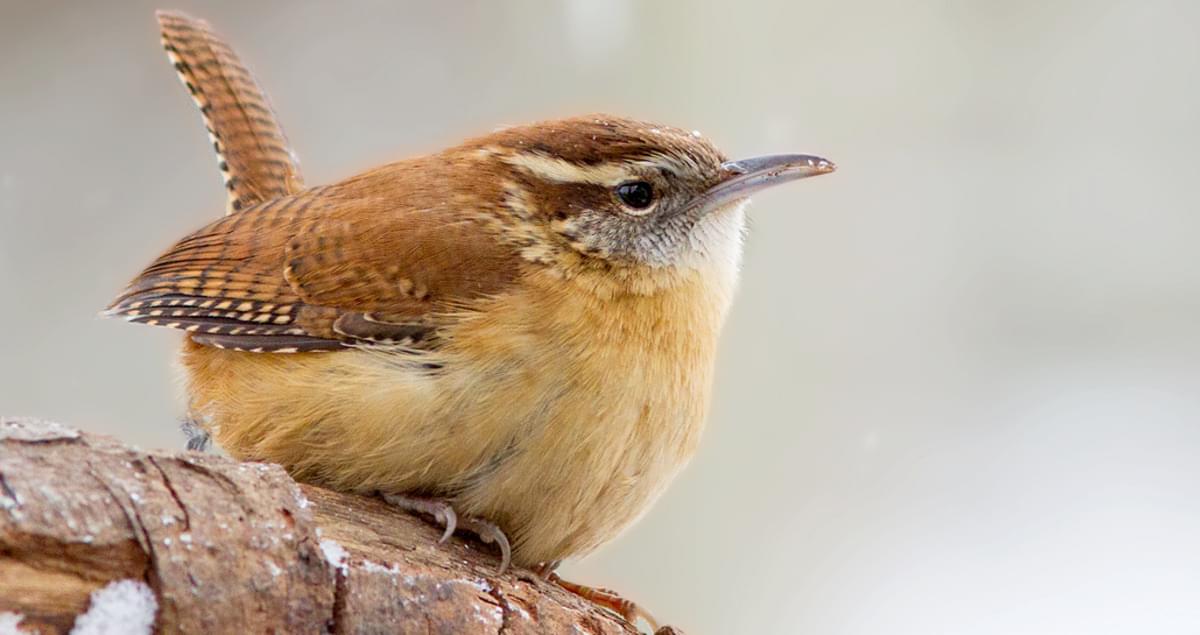
Carolina Wrens are non-migratory birds that can be observed in Alabama throughout the year. They make appearances in an impressive 49% of summer checklists and 42% of winter checklists in the state.
These wrens exhibit a shy nature and are characterized by their dark brown upperparts and lighter brown underparts. They possess a distinct white eyebrow stripe, an upright tail, and are known for their loud and melodious “teakettle” song.
Scientifically referred to as Thryothorus ludovicianus, Carolina Wrens typically measure between 4.7 to 5.5 inches (12 to 14 cm) in length. They weigh around 0.6 to 0.8 ounces (18 to 22 g) and have a wingspan of approximately 11.4 inches (29 cm).
Carolina Wrens are year-round residents in the eastern and southeastern regions of the United States. They can be found in wooded areas or densely vegetated locations, and they may also visit backyard feeders.
To attract Carolina Wrens to your own backyard, offer suet feeders, hulled sunflower seeds, or peanut hearts in large tube feeders or on platform feeders.
While some species of wrens are commonly spotted in Alabama’s backyards, others may require venturing into marshy areas to catch a glimpse of them.
4. House Finch – Female
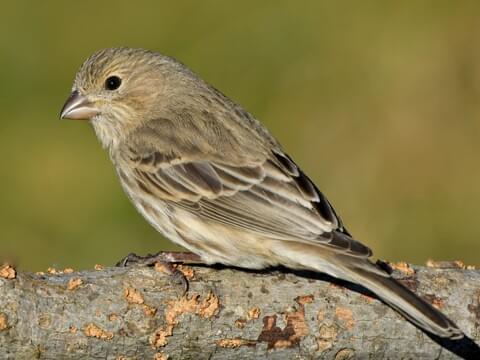
House Finches are permanent residents of Alabama, staying throughout the year without migrating. They can be found in approximately 25% of summer checklists and 31% of winter checklists.
Female House Finches display a brown-streaked plumage all over, while male House Finches exhibit a distinctive red head and breast, with the rest of their bodies predominantly brown-streaked.
Scientifically known as Haemorhous mexicanus, House Finches were originally found only in western states of the United States. However, they were introduced to eastern states and have thrived, often outcompeting Purple Finches.
House Finches can be spotted in various habitats such as parks, farms, forest edges, and backyard feeders, where they tend to gather in noisy groups that are hard to overlook.
To attract House Finches to your backyard feeders, provide them with black oil sunflower seeds or nyjer seeds in tube feeders or platform feeders.
It’s worth noting that not all finches in Alabama exhibit brown coloring; some may display more vibrant hues.
5. Eastern Towhee
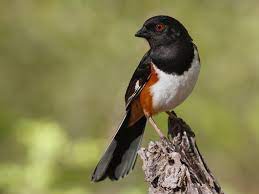
Eastern Towhees are a year-round presence in Alabama, appearing in approximately 29% of summer checklists and 21% of winter checklists.
These captivating birds belong to the large sparrow family and are comparable in size to robins. Male Eastern Towhees showcase a striking appearance, with a black head, throat, and back, reddish sides, a long tail, and a white belly. In contrast, females possess similar features but with a brown coloration instead of black.
Scientifically referred to as Pipilo erythrophthalmus, Eastern Towhees typically measure between 6.8 to 8.2 inches (17.3 to 20.8 cm) in length. They weigh around 1.1 to 1.8 ounces (32 to 52 g) and boast a wingspan of approximately 7.9 to 11.0 inches (20 to 28 cm). While Eastern Towhees reside year-round in southeastern US states, those from more northern regions migrate south for the winter.
You can spot Eastern Towhees as they forage in the undergrowth and along the borders of forests and thickets. They have a penchant for rummaging through vegetation in search of food.
Eastern Towhees construct their nests on the ground, often concealed within fallen leaves. These nests are crafted using twigs, bark, and leaves, while the interiors are lined with soft grass and animal hair. A typical clutch consists of up to six eggs, which take slightly less than two weeks to hatch. The young birds remain in the nest for a similar duration before they are ready to fledge.
To attract Eastern Towhees to your backyard, create overgrown borders or areas with dense vegetation. Additionally, provide platform feeders stocked with black oil sunflower seeds, hulled sunflower seeds, cracked corn, and millet, as these are favored food sources for these birds.
Fun fact: Eastern Towhees have a fondness for sunlight and can often be found on slopes facing the south, where they can bask in the warmth of the sun.
6. American Robin

American Robins are a year-round presence in Alabama, with higher frequencies of sightings occurring from November to March. They are recorded in approximately 18% of summer checklists and 34% of winter checklists.
These birds are commonly seen foraging on lawns, where they feed on earthworms. They possess black heads and backs, accompanied by red or orange breasts. During the winter, American Robins tend to roost in trees, making it more likely to spot them in your backyard during the spring season.
Scientifically known as Turdus migratorius, American Robins reside throughout the lower 48 states and along the coasts of western Canada and Alaska. Those that breed in Canada and inland Alaska migrate south for the winter.
American Robins can be found in various habitats, ranging from woodlands, forests, and mountains to fields, parks, and lawns. They have a diet that includes earthworms, insects, snails, and fruits.
To attract American Robins to your backyard, offer them a selection of sunflower seeds, suet, peanut hearts, fruit, and mealworms. Platform feeders or scattering food on the ground are suitable feeding methods. Additionally, consider planting native berry-producing plants such as juniper, sumac, hawthorn, and dogwood to provide an additional food source for these birds.
7. Brown Thrasher
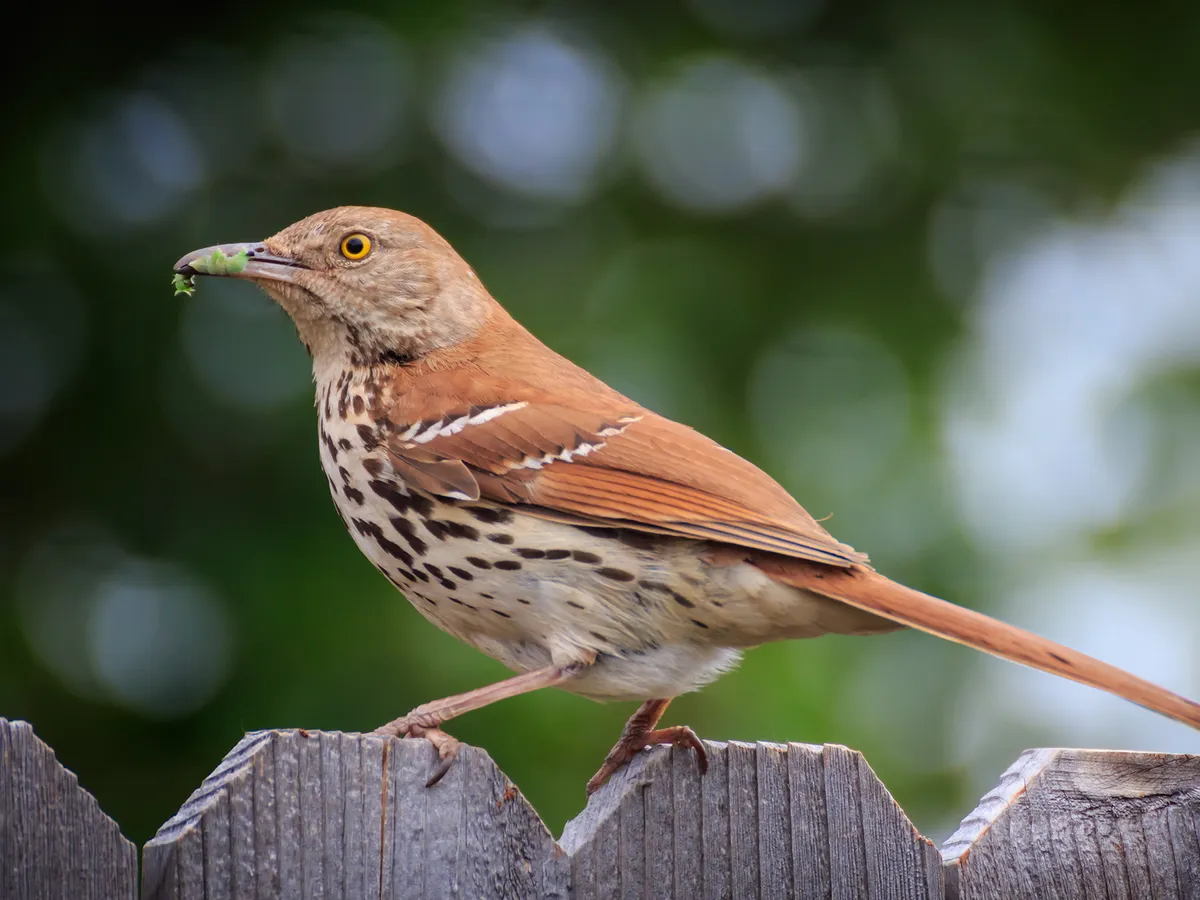
Brown Thrashers can be observed in Alabama throughout the year. They are documented in approximately 22% of summer checklists and 14% of winter checklists.
These birds are recognized for their size and elongated proportions, similar to that of a robin. Brown Thrashers exhibit brown plumage on their backs and white-streaked chests and bellies. Their faces are adorned with gray feathers and bright yellow eyes.
Scientifically referred to as Toxostoma rufum, Brown Thrashers inhabit central and eastern regions of North America. While individuals in the southeastern part of their range remain resident year-round, those in more northern areas undertake migration and move south for the winter.
Despite their size, Brown Thrashers can be elusive due to their preference for thickets and shrubbery. However, their presence is often detected by the rustling sounds they create while foraging along the ground in search of insects within leaf litter and soil. They have a diverse diet that includes berries, beetles, and flying insects captured in mid-air.
One remarkable aspect of Brown Thrashers is their vast repertoire of songs. They are highly skilled songbirds, known to produce over 1,000 different song types, making it one of the largest repertoires among North American songbirds.
To attract Brown Thrashers to your backyard, provide dense cover and include berry shrubs in your landscaping. They will also visit to collect fallen seeds beneath feeders.
8. Eastern Phoebe
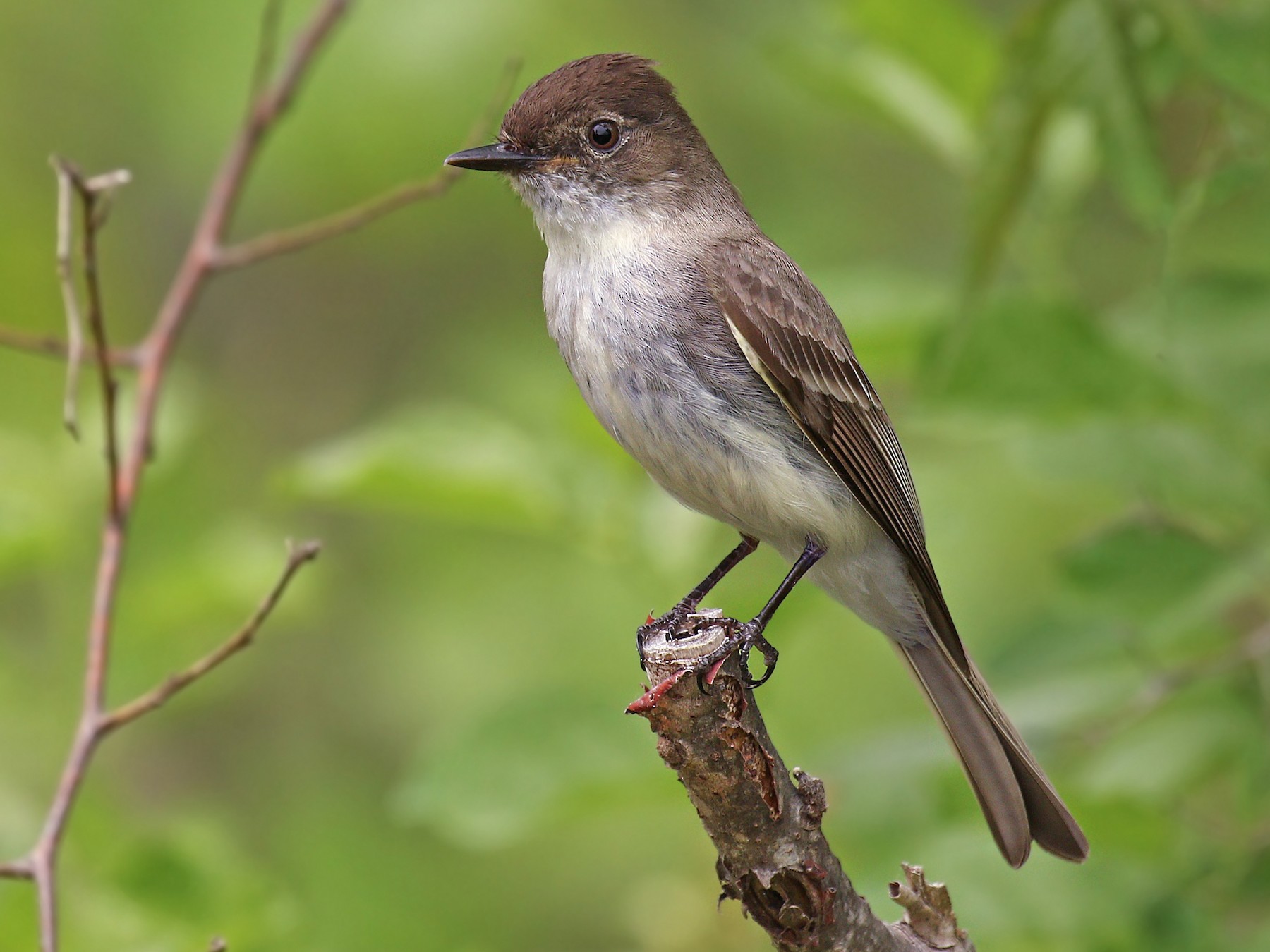
Eastern Phoebes are more commonly observed in winter in Alabama, although some individuals reside year-round in the northwest region of the state. They are documented in around 13% of summer checklists and 23% of winter checklists.
These plump songbirds exhibit a grayish-brown coloration on their backs, with whitish underparts and slightly darker heads.
Scientifically known as Sayornis phoebe, Eastern Phoebes are migratory birds. They breed across northeastern and central states of the United States, extending into Canada, before embarking on migration to southeastern states of the US and Mexico for the winter. Some individuals may remain in the southern parts of their range throughout the year.
Eastern Phoebes are typically solitary birds, often found in quiet woodlands. They can be spotted perched on low branches, wagging their tails. Unlike some other species, they do not form pairs or flocks.
As flycatchers, Eastern Phoebes primarily feed on flying insects. However, they also consume spiders, other insects, small fruits, and seeds. They often build their nests on structures such as bridges, barns, or houses, constructing them from mud and grass.
To attract Eastern Phoebes to your backyard, consider providing a nest box or incorporating native plants that produce berries. These features can make your space more enticing for these charming birds.
9. Chipping Sparrow
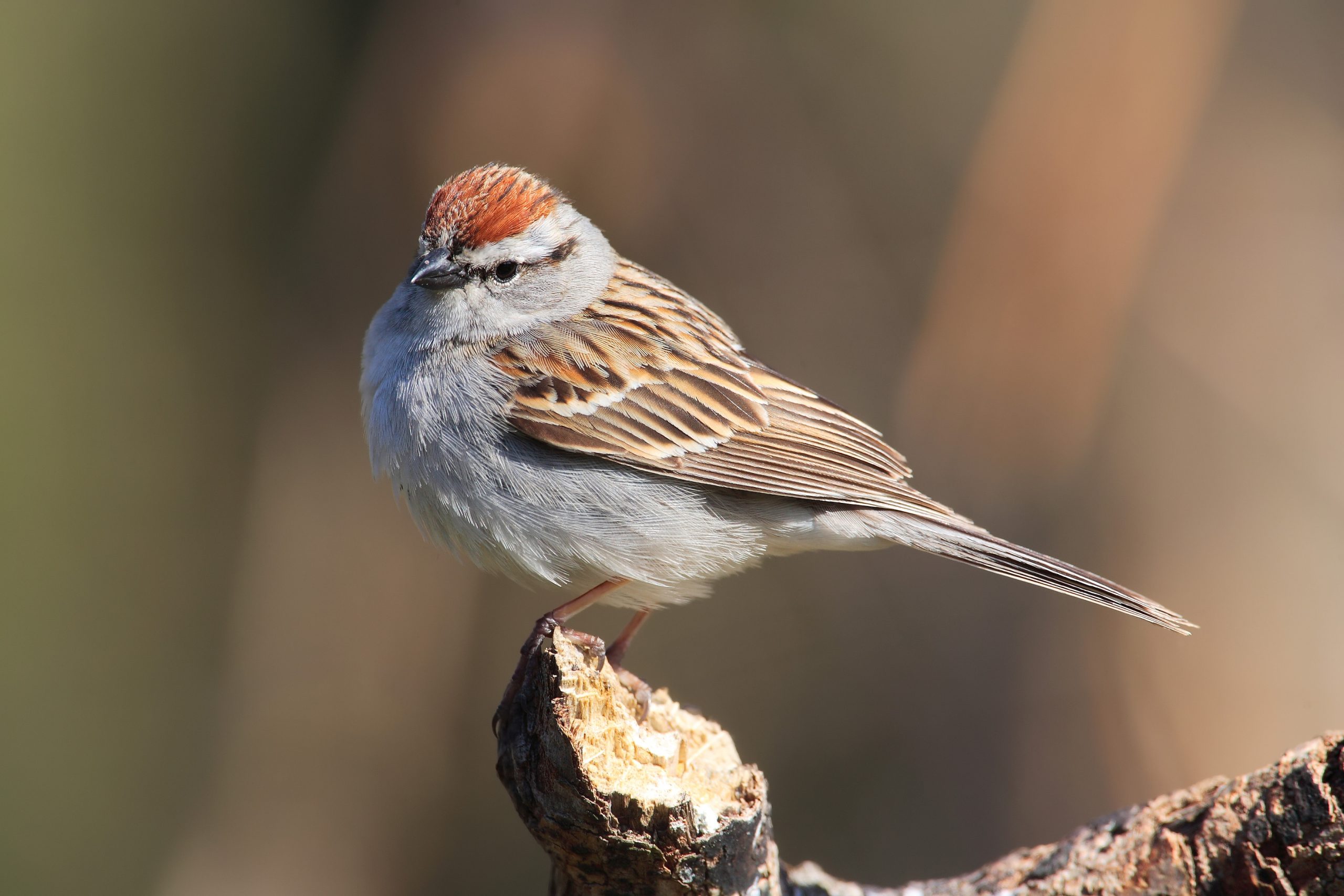
While some Chipping Sparrows can be spotted in Alabama throughout the year, they are more commonly seen during the winter season, from November to mid-April. They appear in approximately 12% of summer checklists and 23% of winter checklists.
Chipping Sparrows are slender birds with elongated tails. They display a grayish belly and a back adorned with brown and black streaks. They feature a rusty crown and a black eye line. During the winter, their colors become more muted.
Scientifically referred to as Spizella passerina, Chipping Sparrows breed in the United States and Canada during the summer before migrating to Mexico and Florida for the winter. However, some individuals remain in southern states year-round.
These sparrows can be found in small flocks on open ground and are known to visit backyards in search of various types of birdseed.
To attract Chipping Sparrows to your backyard, provide seeds or cracked corn on open feeders such as hoppers or platforms. These feeding setups are particularly effective in enticing these delightful birds to your outdoor space.
10. American Goldfinch – Female
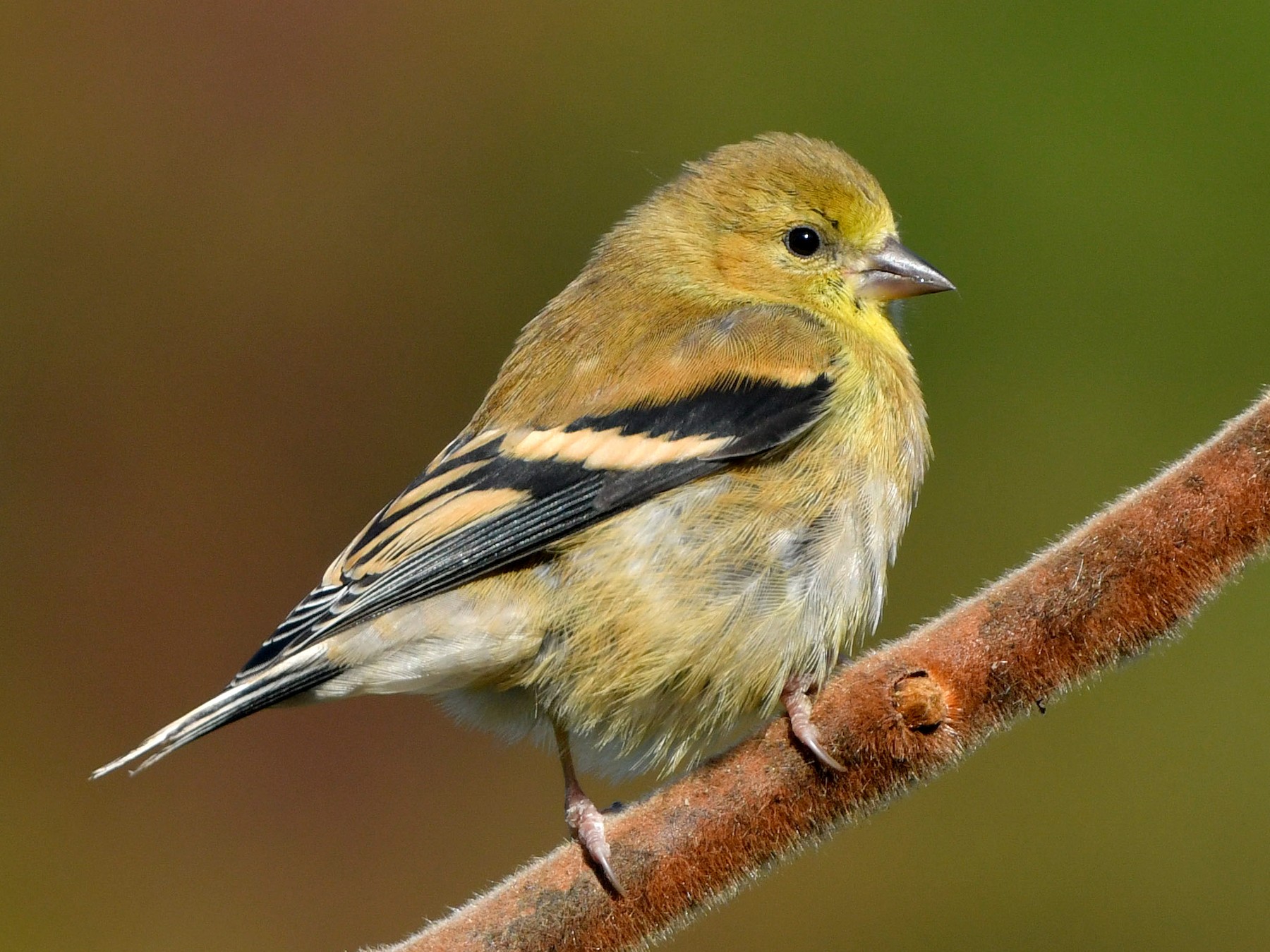
In southern Alabama, American Goldfinches are primarily observed during winter, although some individuals remain in the northern parts of the state throughout the year. They are documented in approximately 9% of summer checklists and 28% of winter checklists.
These charming birds are well-known for the vibrant yellow and black plumage displayed by males during the spring season. In contrast, females and males in winter exhibit a more subdued brown coloring.
Scientifically referred to as Spinus tristis, American Goldfinches can be found across most of North America and are typically resident year-round. However, those that breed in Canada and the Midwest embark on migration to southern states of the US for the winter.
These goldfinches can be spotted foraging in weedy fields and overgrown areas, particularly around sunflower, thistle, and aster plants. They are also common visitors to suburbs, parks, and backyards.
To attract American Goldfinches to your backyard, consider planting thistles and milkweed, as these plants are especially appealing to them. Additionally, they are known to frequent most types of bird feeders and have a preference for sunflower seeds and nyjer seeds.
11. White-throated Sparrow
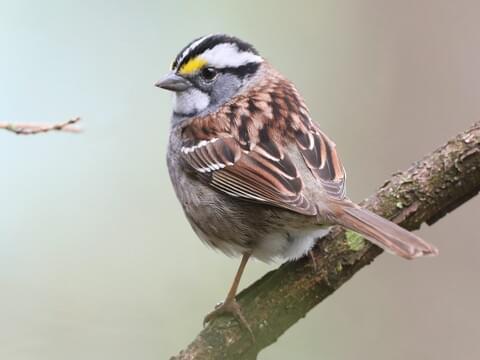
During winter, White-throated Sparrows are frequently observed in Alabama, making appearances in around 26% of checklists during this season. These sparrows begin arriving as early as August, and some can be seen until July, but the optimal months for spotting them are from November to mid-April.
White-throated Sparrows stand out with their distinctive black and white striped heads, bright white throats, and yellow coloring between the eye and bill. Their backs are brown, while their underparts are gray.
Scientifically known as Zonotrichia albicollis, White-throated Sparrows are migratory birds. They primarily breed in Canada and then migrate south to eastern and southern states of the US, as well as the Pacific Coast, for the winter.
These sparrows can be found on the ground in forests, woodlands, and along the edges of wooded areas, often congregating in large flocks.
The diet of White-throated Sparrows consists mainly of grass and weed seeds, as well as fruits such as grapes, sumac, mountain ash, blueberries, blackberries, and dogwood. They also feed on many insects found on the forest floor, particularly during the summer months.
To attract White-throated Sparrows to your backyard, provide millet and black oil sunflower seeds on platform feeders. These food offerings can entice these delightful sparrows to visit your outdoor space.
(Note: The last sentence of the provided text seems to be unrelated to White-throated Sparrows and is repeated from a previous response about attracting Chipping Sparrows.)
12. Brown-headed Cowbird – Female
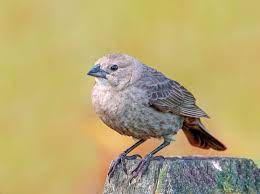
Brown-headed Cowbirds are primarily observed during the summer months, from March to July, but they also reside in Alabama throughout the year. They are documented in approximately 17% of summer checklists and 7% of winter checklists.
Female Brown-headed Cowbirds exhibit a brown coloration throughout their bodies with slight streaking. On the other hand, male Brown-headed Cowbirds are larger in size, with black bodies, brown heads, and short tails.
Scientifically known as Molothrus ater, Brown-headed Cowbirds can be found year-round in eastern US states, southern US states, and along the Pacific Coast. However, individuals that breed in northern and western US states and Canada undertake migration and move south for the winter.
These birds are often considered a nuisance due to their parasitic nature. They engage in brood parasitism, which involves destroying the eggs of smaller songbirds in order to lay their own eggs in the host’s nest. The host bird then unknowingly fosters and raises the chicks of the Brown-headed Cowbirds, which can negatively impact the reproductive success of the host species.
13. Great-crested Flycatcher
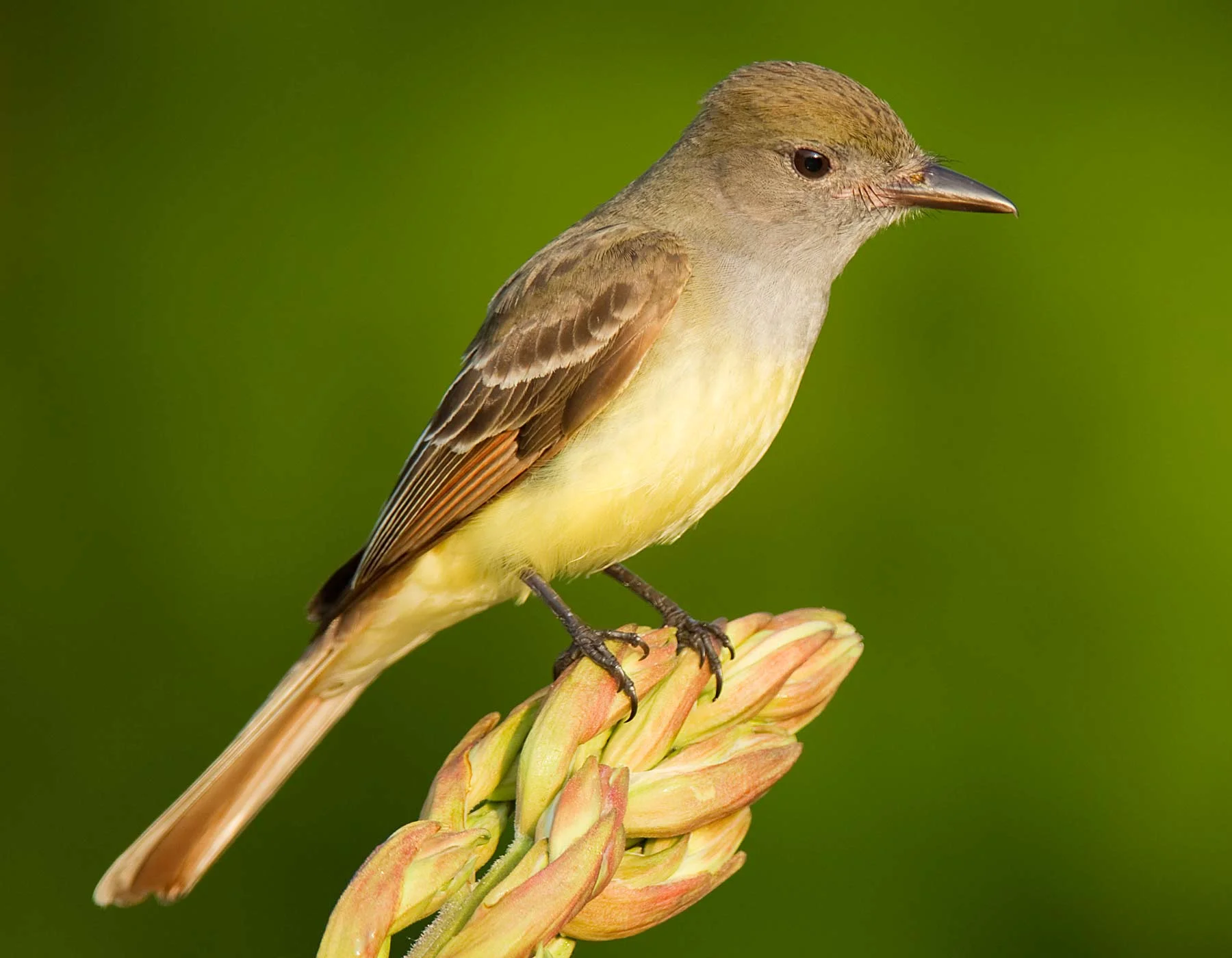
From March to October, Great Crested Flycatchers can be found in Alabama during the breeding season. They are documented in approximately 23% of summer checklists.
These flycatchers exhibit brown coloring on their backs, a yellow belly, and a gray throat. Their wing and tail feathers display reddish flashes. While they possess a crest, it may not be very noticeable.
Scientifically referred to as Myiarchus crinitus, Great Crested Flycatchers breed across a significant portion of eastern North America. During the winter, they migrate to southern Florida, southern Mexico, and Central America.
These birds perch high up in woodlands, patiently awaiting the arrival of large insects such as butterflies, grasshoppers, moths, wasps, and spiders. They can be found in mixed woodlands and at the edges of clearings, parks, and tree-lined neighborhoods. Additionally, they may be spotted perched on fenceposts or other man-made structures. Great Crested Flycatchers also consume berries and small fruits as part of their diet.
To entice Great Crested Flycatchers to visit your backyard, consider incorporating native plant species into your landscaping. These plants can attract insects, which are a vital food source for these flycatchers. Additionally, leaving brush piles in your yard provides shelter for insects, further attracting the birds.
Planting berry-producing plants is another effective way to attract Great Crested Flycatchers. These birds are known to consume berries and will appreciate the additional food source in your backyard. Additionally, consider installing a nest box specifically designed for Great Crested Flycatchers. They readily take up residence in these boxes and may choose to raise their young there.
By creating a welcoming habitat with native plants, offering food sources like berries, and providing suitable nesting options, you increase the chances of attracting Great Crested Flycatchers to your backyard and enjoying their presence.
14. House Sparrow

House Sparrows, an introduced species in Alabama, can be observed throughout the year. They do not migrate and are present in approximately 9% of both summer and winter checklists for the state.
These sparrows have thrived since their introduction and have become one of the most abundant bird species. They feature gray and brown heads, with white cheeks. Their backs exhibit a combination of black and brown hues, while their bellies are gray.
Scientifically known as Passer domesticus, House Sparrows reside in the United States and southern parts of Canada year-round. They are commonly found in the vicinity of houses and buildings, often displaying a certain level of familiarity and even approaching humans to feed from their hands.
House Sparrows primarily consume grains, seeds, and discarded food. While they can be considered pests due to their non-native status, they can be commonly found in backyards even without intentional feeding.
To attract House Sparrows to your backyard feeders, offer a variety of birdseed, including millet, corn, and sunflower seeds. These food choices are likely to entice these sparrows and encourage their visits to your feeding stations.
15. Northern Flicker
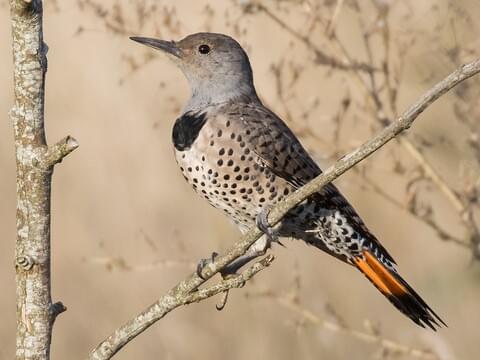
Northern Flickers can be observed in the northwest region of Alabama throughout the year, with a higher likelihood of sightings during the winter season. They are documented in approximately 3% of summer checklists and 12% of winter checklists.
These woodpeckers are characterized by their large size, brown plumage adorned with black spots, and a noticeable white patch on their rump when in flight. Male Northern Flickers also exhibit a red nape of the neck.
It’s worth noting that Northern Flickers display red or yellow flashes in their wings and tail, which vary depending on their geographical origin. Red-shafted birds are found in the western regions, while yellow-shafted birds inhabit the eastern areas.
Scientifically referred to as Colaptes auratus, Northern Flickers can be found across the United States throughout the year, and they breed in Canada during the summer. Individuals that breed in Canada migrate south for the winter.
Ants and beetles form a significant part of the Northern Flickers’ diet, along with fruits and seeds. These woodpeckers can often be seen on the ground, using their curved bills to dig and forage.
To attract Northern Flickers to your backyard, provide suet feeders. These birds are known to be attracted to suet, and by offering it, you may also attract other woodpecker species that can be found in Alabama.
16. Song Sparrow
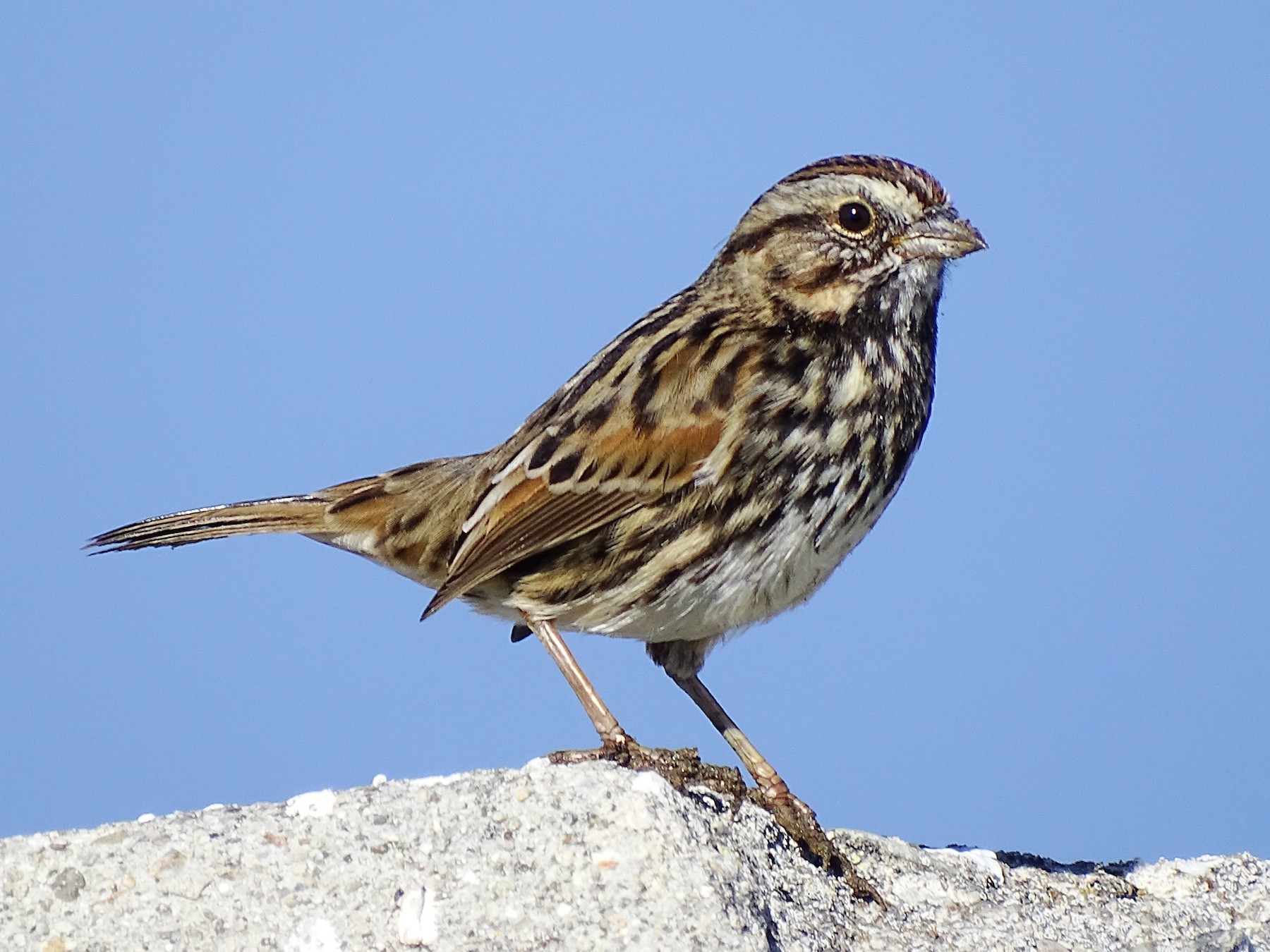
During winter, Song Sparrows are more commonly observed in Alabama and are documented in approximately 17% of checklists. Their highest occurrence is from November to March, but some individuals can still be spotted throughout the year, appearing in around 3% of summer checklists.
While Song Sparrows may not possess striking appearances compared to other backyard birds, they compensate with their constant melodic songs, which they utilize to attract mates during the spring and summer seasons.
Scientifically known as Melospiza melodia, Song Sparrows reside year-round in the northern states of the US. However, individuals that breed in Canada undertake migration and move to southern states of the US for the winter.
These sparrows can be found in open, shrubby, and wet areas, often perched on low shrubs while singing. They are also frequently encountered at backyard feeders.
The diet of Song Sparrows consists of a diverse range of insects and plants, including beetles, caterpillars, midges, spiders, and earthworms. Additionally, they consume items such as buckwheat, sunflower seeds, raspberries, wild cherries, blackberries, wheat, and rice.
To attract Song Sparrows to your backyard feeders, provide black oil sunflower seeds, cracked corn, and nyjer on platform feeders. These food offerings are likely to entice these sparrows and encourage their visits to your feeding stations.
Alabama is home to a diverse array of sparrows, and it can be quite remarkable to witness the variety of these birds in the region. By familiarizing yourself with their unique songs and interesting facts, you can enhance your ability to identify them with greater ease.
17. Cedar Waxwing
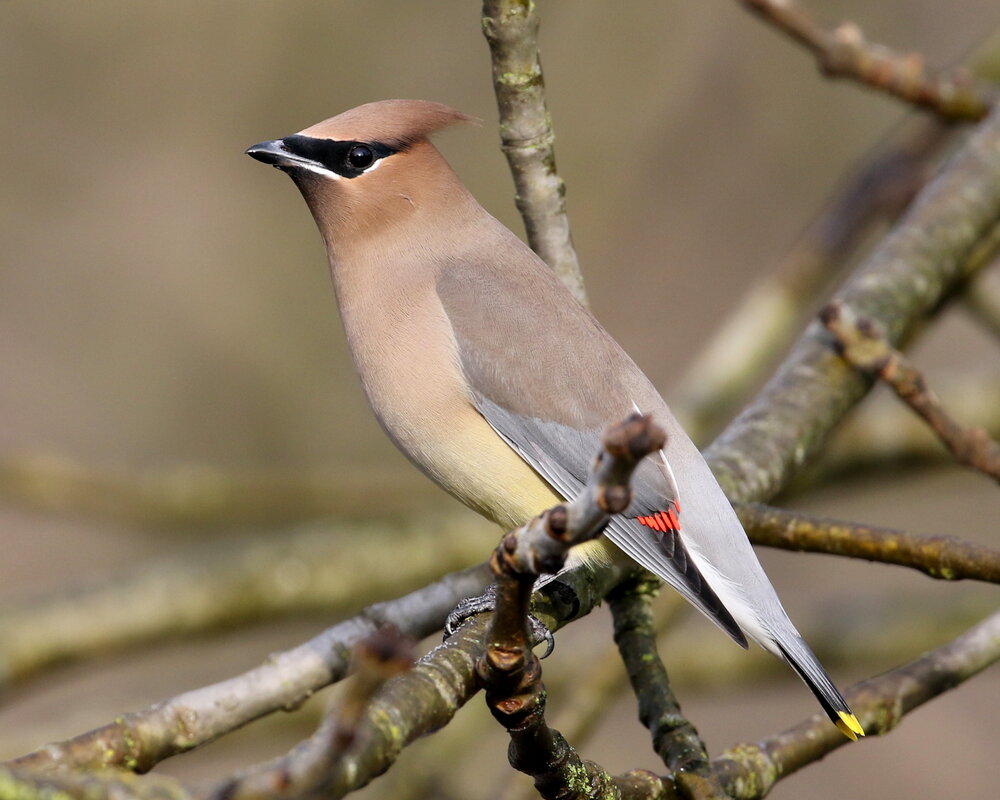
During the winter season, Cedar Waxwings are primarily observed in Alabama, appearing in around 11% of checklists during this time. Their presence in the state spans from mid-September until May.
Cedar Waxwings are elegant and sociable birds. They showcase a pale brown coloring on their head, chest, and crest, which gradually transitions to gray on their back, wings, and tail. Their belly is a delicate pale yellow, becoming bright yellow towards the tail. These birds also feature a narrow black mask that covers their eyes and striking bright red wingtips.
Scientifically referred to as Bombycilla cedrorum, Cedar Waxwings reside year-round in the northern half of the United States. However, individuals that breed in Canada undertake migration and move to the southern half of the country for the winter season.
These birds emit high-pitched calls and can be found in various habitats, including berry bushes, woodlands, and near streams.
To attract Cedar Waxwings to your backyard, consider planting native trees and shrubs that produce small fruits. Serviceberry, dogwood, juniper, winterberry, and hawthorn are excellent options. Additionally, you can try offering fruit on platform feeders as an enticing food source for these beautiful birds.
18. Common Yellowthroat
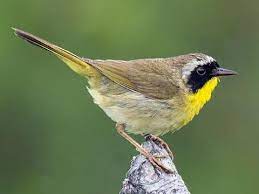
Southern Alabama serves as a year-round habitat for Common Yellowthroats, although they are more prevalent in the northern part of the state during the breeding season. Their presence is documented in approximately 10% of summer checklists and 2% of winter checklists for Alabama.
Common Yellowthroats are small songbirds characterized by a brownish hue on their backs and vibrant yellow plumage on their undersides, accompanied by long tails. The males sport black masks across their faces, while the brightness of their yellow coloring can vary geographically, with some individuals displaying a more olive tone underneath.
Scientifically known as Geothlypis trichas, Common Yellowthroats spend their summers breeding across most of North America, excluding Alaska and northern Canada. Some individuals remain along the Gulf Coast and Pacific Southwest throughout the year, while others embark on migration towards the south for the winter season.
These birds are often found in marshy or wetland areas and brushy fields, preferring habitats with thick and tangled vegetation.
To attract Common Yellowthroats to larger backyards, it is beneficial to provide dense vegetation and incorporate native plants that can attract insects, as they form a significant part of their diet.
Common Yellowthroats belong to the warbler family, and while they are indeed captivating to observe, there are numerous other species of warblers that can be found in Alabama. Each species possesses its own mesmerizing songs, which can be a delightful experience to listen to and learn.
19. Wood Thrush
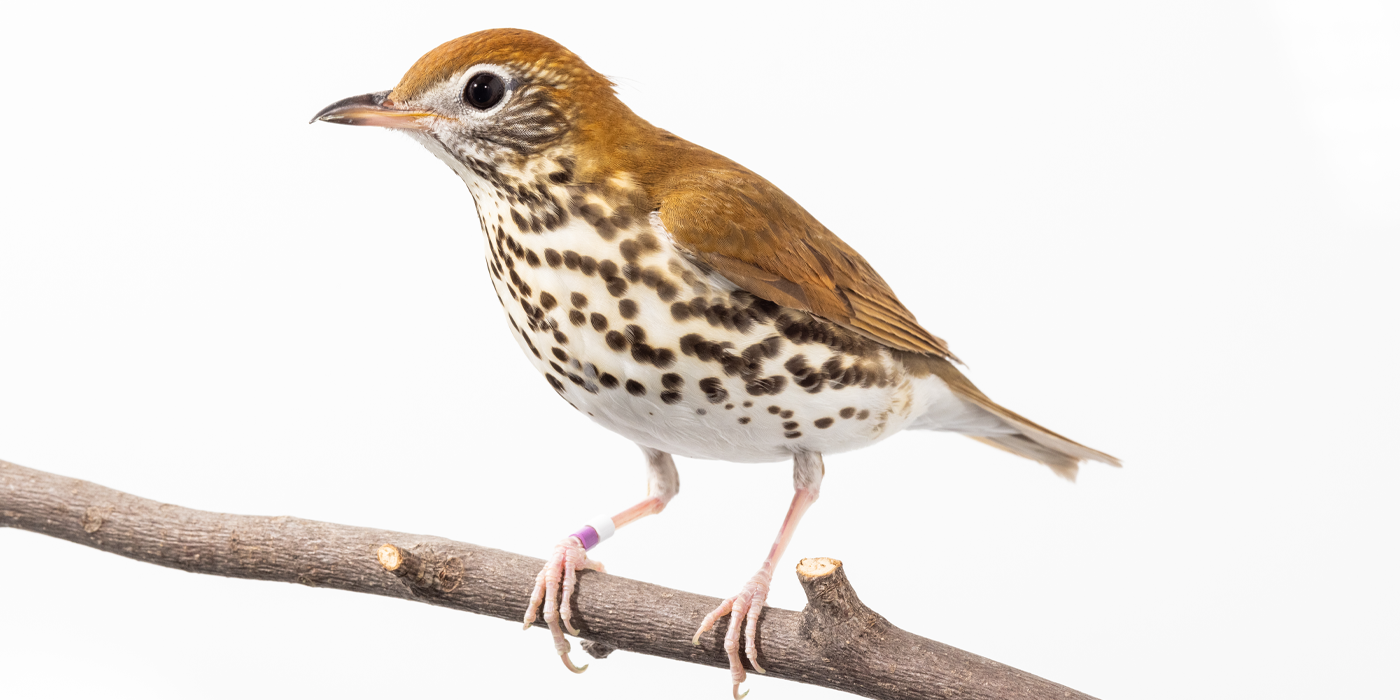
Wood Thrushes are commonly observed in Alabama during their breeding season, spanning from March to October. They are documented in approximately 8% of checklists during this period.
With their plump bodies and distinct white bellies adorned with black spots, Wood Thrushes possess a slightly comical appearance. They exhibit a brown hue on their backs, complemented by reddish tones on the crown and upper back.
Scientifically referred to as Hylocichla mustelina, Wood Thrushes undertake a remarkable migration journey. They traverse from eastern US states, crossing the Gulf of Mexico in a single night, before reaching their wintering grounds in Central America.
These birds prefer to remain hidden, foraging amidst leaf litter in mature forests in search of insects like beetles and flies. During the springtime, their presence is often indicated by their melodious and flute-like song.
To attract Wood Thrushes to your backyard, consider planting native species of plants that can attract insects, while also leaving brush piles to provide additional habitat and food sources. Furthermore, incorporating berry-producing plants and providing nest boxes can further encourage these birds to take up residence in your surroundings.
20. Field Sparrow
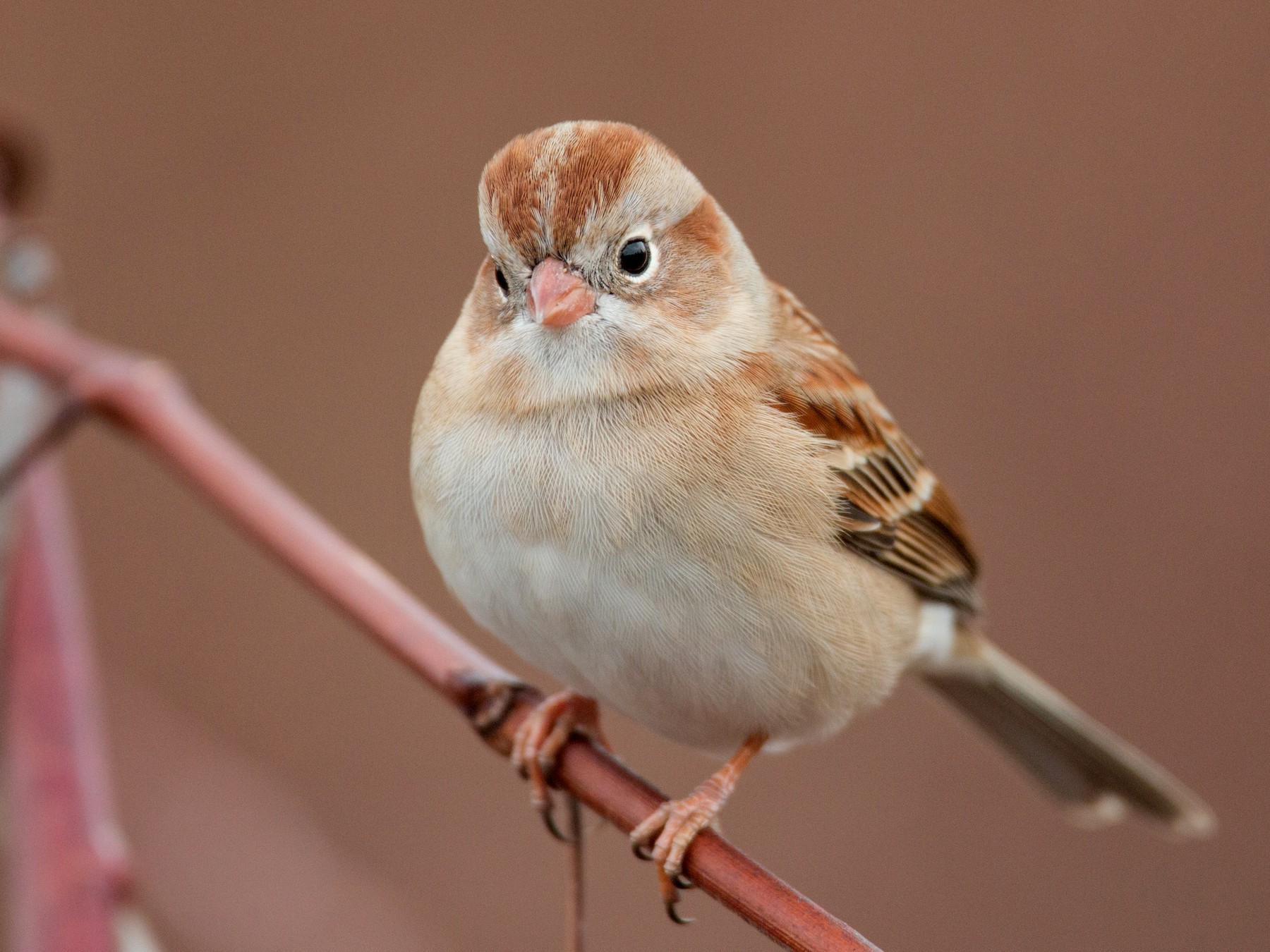
Field Sparrows can be observed throughout the year in Alabama and are found in up to 5% of both summer and winter checklists.
These small and slender birds exhibit brown backs streaked with black. Their undersides and heads are gray, while they possess a reddish crown and a distinctive pink bill.
Scientifically known as Spizella pusilla, Field Sparrows reside year-round in eastern US states. However, individuals that breed in the Midwest migrate south for the winter season.
During the breeding season, Field Sparrows are relatively easier to spot as the males perch and sing in the early mornings. Outside of this period, they quietly feed on weeds and seeds, often preferring abandoned fields. Their shy nature makes them easy to miss.
Field Sparrows construct their nests on the ground for the first brood and gradually build them higher as the breeding season progresses. The nests are crafted from grass, and they typically lay up to five eggs, which hatch in approximately two weeks. The young birds then take about a week to fledge.
To attract Field Sparrows to your backyard, offer cracked corn, hulled sunflower seeds, and millet as food options. These enticing offerings can help draw their presence and provide them with a reliable food source.
21. Swamp Sparrow
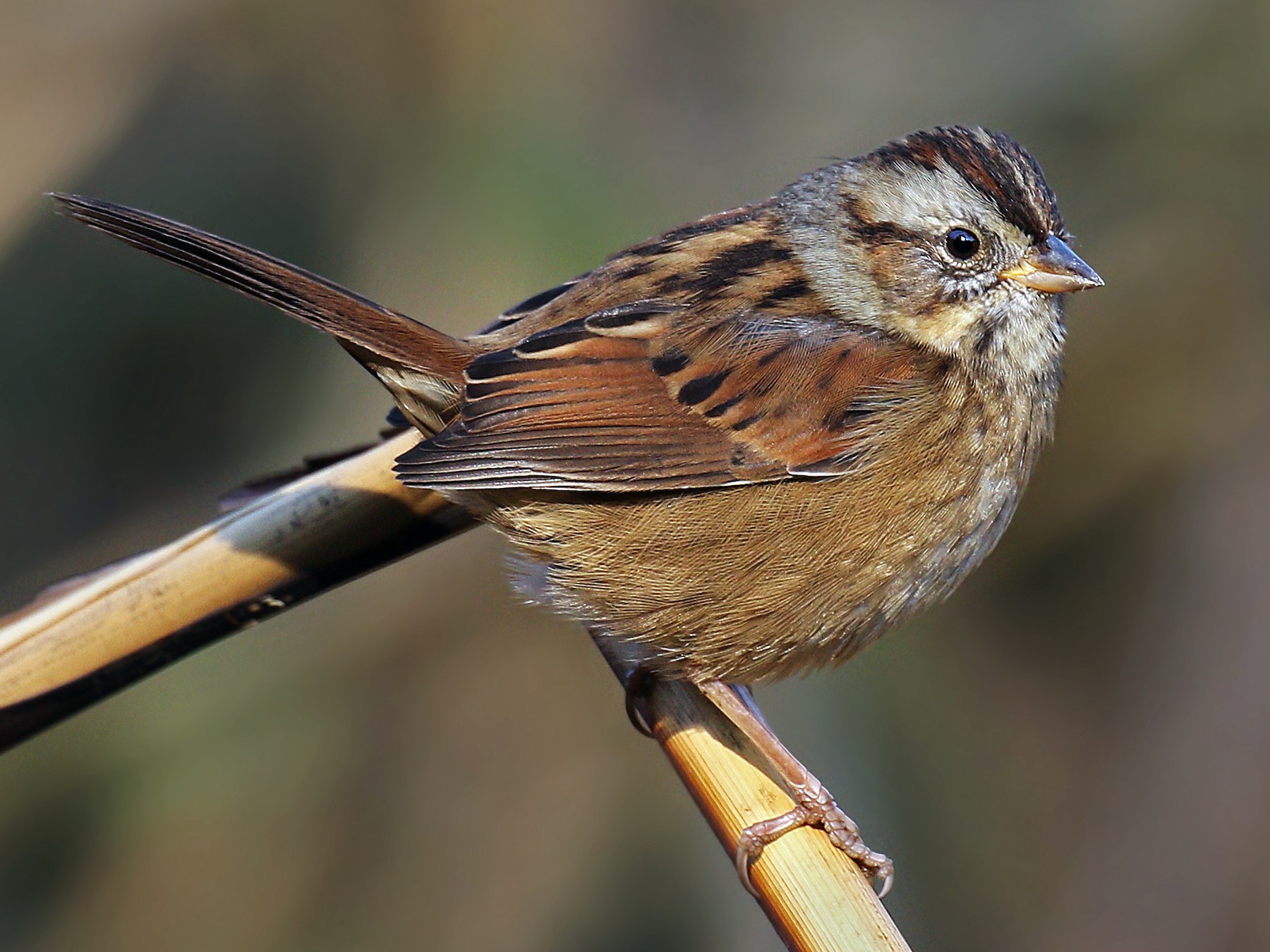
During the winter season in Alabama, Swamp Sparrows make an appearance in approximately 7% of checklists. They inhabit the state from mid-September until May, seeking refuge in its wintery environment.
These sparrows are characterized by their dark brown backs, complemented by rusty crowns and wings. Their breasts exhibit a gray hue, while their throats are white. Their heads are gray, adorned with brown faces featuring a distinct dark eye line and a yellow tip on their beak.
Scientifically referred to as Melospiza georgiana, Swamp Sparrows are primarily found in the eastern regions. They breed in Canada, northeastern US states, and North Central US states, before embarking on migration towards eastern and southern US states, as well as Mexico.
As their name suggests, Swamp Sparrows are commonly encountered in wetlands, swamps, bogs, and coastal marshes. Their diet consists of seeds and fruit, with a particular focus on these food sources during the winter season. In the springtime, they incorporate a higher proportion of insects into their diet.
Swamp Sparrows construct their nests, which are typically concealed within vegetation close to or on the ground. These nests are crafted from twigs, leaves, and cattails, lined with grass and other plant materials.
It is worth noting that Swamp Sparrows do not frequently visit backyards, except during migration, and even then, they are more likely to be found in yards with abundant vegetation and a water source.
22. Savannah Sparrow
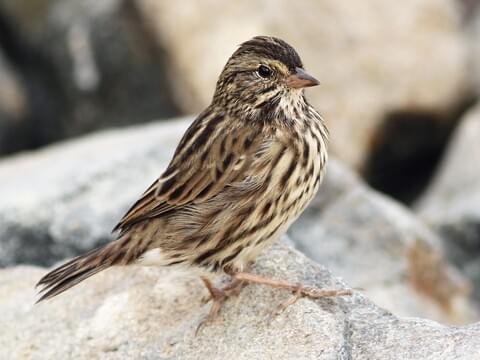
During the winter season in Alabama, Savannah Sparrows can be observed from mid-September until May and are found in approximately 6% of winter checklists.
If you manage to get a close look at a Savannah Sparrow, you’ll notice its unique features. This brown bird displays a noticeable yellow patch by the eye, adding a splash of color to its appearance. It also possesses short tails and exhibits streaky brown plumage.
Scientifically known as Passerculus sandwichensis, Savannah Sparrows breed in Canada and the United States before embarking on migration towards southern US states and Mexico for the winter.
These sparrows can be found foraging on the ground in open areas, particularly grasslands. During the breeding season, their diet primarily consists of insects and spiders, while in the winter months, they shift their focus to feeding on seeds.
Nests of Savannah Sparrows are constructed on or near the ground using grass as building materials. They typically lay up to six eggs, which take around two weeks to hatch. After hatching, it takes an additional one to two weeks for the young birds to fledge.
Savannah Sparrows are not regular visitors to feeders. However, they may occasionally visit your yard if you create a habitat that includes brush piles, maintain long grass, and live in close proximity to fields.
23. Pine Siskin

Pine Siskins are winter visitors in Alabama, arriving as early as September and staying until June, with the peak months for spotting them being November to April. They are found in approximately 7% of winter checklists.
These small brown finches, known as Pine Siskins, showcase distinctive yellow streaks on their wings and tail. They possess a forked tail, pointed wings, and a short, pointed bill.
Scientifically referred to as Spinus Pinus, Pine Siskins establish year-round habitats in pine forests across western states and along the Canadian border. Some individuals also breed in Canada before migrating south for the winter.
The distribution of Pine Siskins across North America is influenced by the availability of pine cone crops. They are known to feed predominantly on seeds from conifer trees, as their name suggests. However, they also consume young buds and seeds from grasses and weeds.
These delightful finches add a touch of charm to winter landscapes, particularly when they congregate at feeders offering nyjer or sunflower seeds.
To entice Pine Siskins to visit your backyard, set up thistle and nyjer feeders. These finches have a particular affinity for these types of feeders. Additionally, they are also attracted to black oil sunflower seeds and suet. By providing these food sources, you increase the chances of welcoming Pine Siskins to your outdoor space and enjoying their presence.
24. House Wren
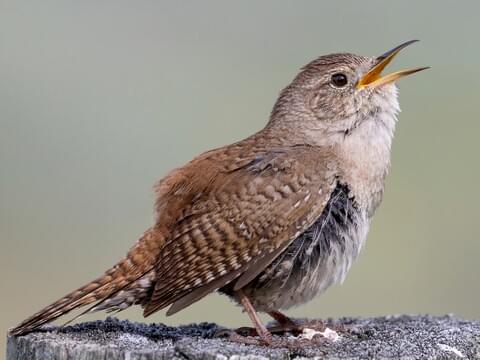
House Wrens are more commonly seen during the winter in Alabama, appearing in about 3% of checklists during this time. These small, unassuming birds have brown plumage with darker barred wings and tails, and they often hold their tails upright.
Scientifically known as Troglodytes aedon, House Wrens breed in the United States and southern Canada during the summer before migrating to southern states and Mexico for the winter.
You can spot House Wrens in various habitats such as backyards, parks, and open woodlands, where they search for insects and spiders. They are known for their energetic hopping and perching on low branches while singing their cheerful songs.
Despite their small size, House Wrens are quite territorial and assertive when it comes to securing the best nest holes. They may even engage in aggressive behavior, harassing larger birds and sometimes removing eggs or nestlings from a desired nest site.
To attract House Wrens to your backyard, you can create brush piles or put up a nest box, providing them with suitable nesting opportunities.
25. Rose-breasted Grosbeak – Female
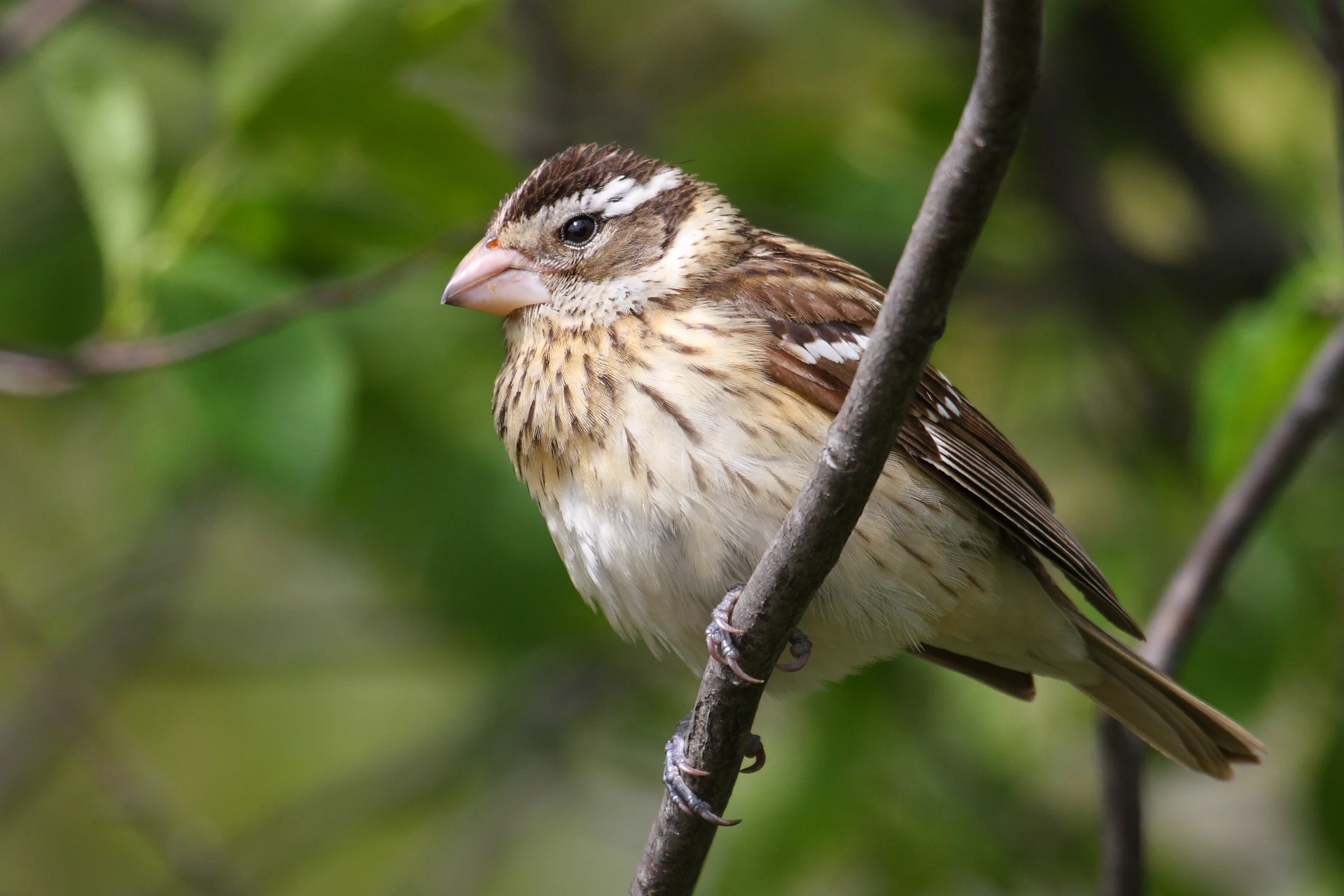
Rose-breasted Grosbeaks are commonly observed during migration in Alabama, particularly in April to May and September to October. They appear in approximately 21% of checklists during spring and 15% during fall.
Female Rose-breasted Grosbeaks and immature males exhibit a brown coloration with notable streaking and a touch of yellow beneath their wings.
In contrast, male Rose-breasted Grosbeaks showcase a striking black-and-white plumage with black heads and backs, white bellies, and vibrant red breasts. They also possess a conspicuous flash of red underneath their wings.
Scientifically known as Pheucticus ludovicianus, these birds breed in northeastern US states, the Midwest, and southern and central Canada. During migration, they can be observed in southeastern US states, while their winter months are spent in Mexico, Central America, and the Caribbean.
Rose-breasted Grosbeaks can be found in various habitats such as forests, parks, and backyards, where they actively search for insects, berries, and seeds.
When constructing their nests, Rose-breasted Grosbeaks typically choose the branches of low trees. These nests consist of loosely-formed twigs, grass, and plants. They lay around five eggs, which incubate for approximately two weeks. Both parents take turns in the incubation process.
To attract Rose-breasted Grosbeaks to your backyard, offering sunflower seeds and peanuts can be enticing for them.
26. Hermit Thrush
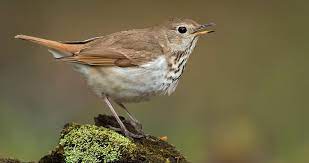
During the winter months, Hermit Thrushes can be found in Alabama, appearing in approximately 6% of checklists at this time. Their presence is most common from October to April.
Hermit Thrushes possess a distinctive upright posture, characterized by chunky bodies and long tails. They exhibit brown coloring on their backs and white undersides, with noticeable spots adorning their throats and breasts.
Scientifically known as Catharus guttatus, these thrushes breed in Canada, northeastern US states, and the western US. During migration, they can be observed in central states before ultimately spending winter along the Pacific Coast, southeastern states, and Mexico.
Foraging primarily on the ground in forest clearings, Hermit Thrushes diligently search through the leaf litter in pursuit of insects. During winter, they also include berries in their diet.
While these thrushes rarely visit backyards, their somewhat melancholic song can be heard during the spring and summer seasons.
27. Purple Finch – Female
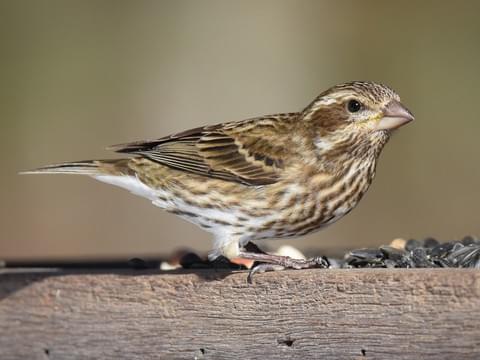
During the winter months, from November to May, Purple Finches are frequently observed in Alabama, making up approximately 8% of checklists during this time.
Female Purple Finches exhibit a brown-streaked appearance throughout their plumage, while males showcase reddish-purple heads and breasts with a mixture of brown on their backs and wings, complemented by a paler belly. They bear a resemblance to House Finches but possess a more prominent reddish hue, particularly on the upper part of their backs.
Scientifically known as Haemorhous purpureus, these finches breed in Canada and migrate to eastern US states for the winter. However, they can be found throughout the year in the northeastern regions and along the Pacific coast.
Purple Finches are commonly found in evergreen forests, where they feed on seeds. Additionally, they also consume buds, nectar, and berries.
Nests of Purple Finches are typically located high up in trees, constructed using twigs, barks, weeds, and moss. The female incubates a clutch of three to five eggs for a period of thirteen days.
To attract Purple Finches to your backyard, consider providing black oil sunflower seeds as a preferred food source.
28. Louisiana Waterthrush
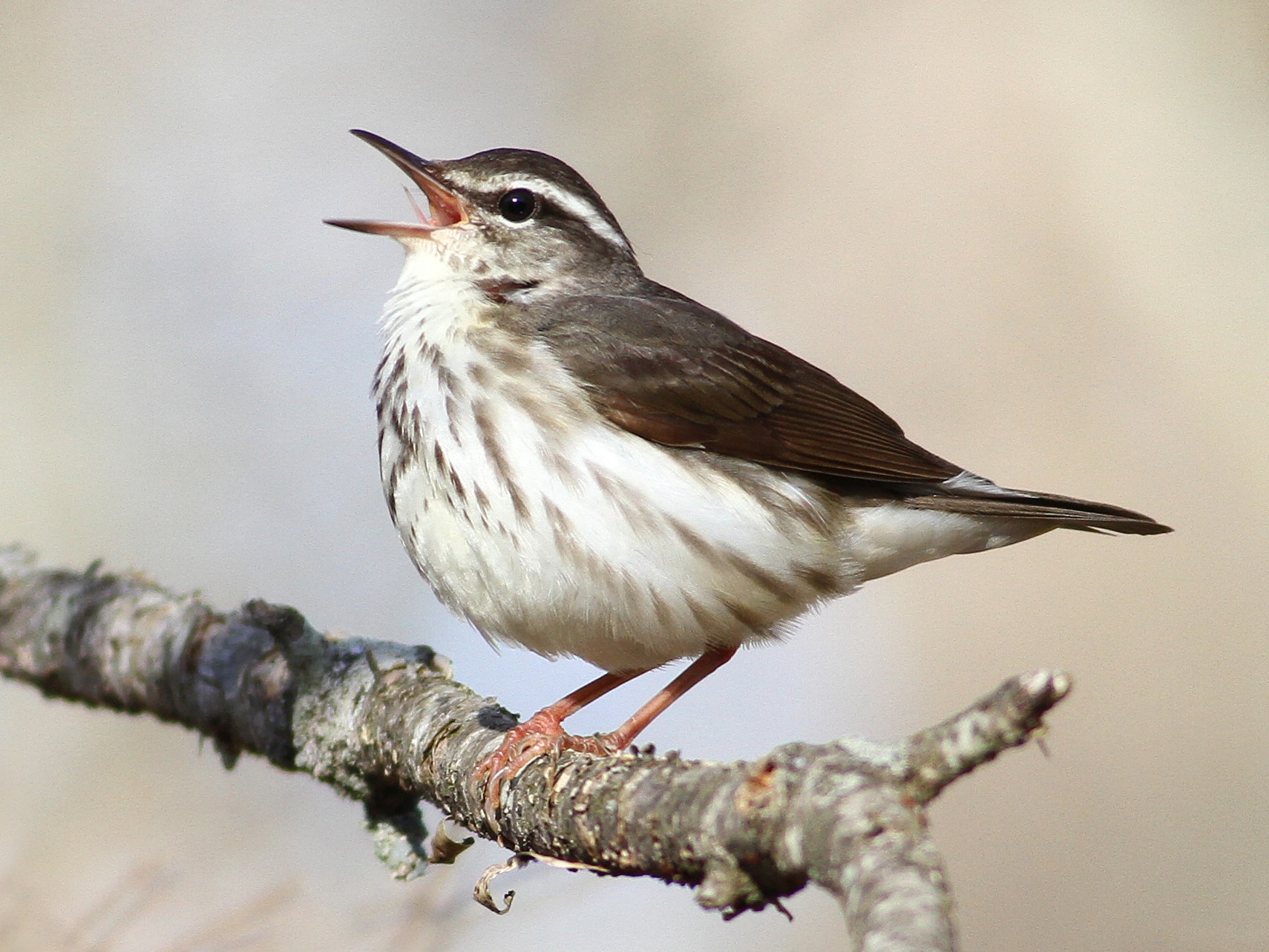
From mid-February to September, Louisiana Waterthrushes can be spotted in Alabama, making up approximately 2% of summer checklists.
Compared to other warblers, Louisiana Waterthrushes may appear rather plain in appearance. They exhibit a brown coloration on their upper parts and a pale hue on their underparts. A distinguishing feature is their white eyebrow stripe and long pink legs.
Scientifically known as Parkesia motacilla, these waterthrushes breed in eastern US states and can be observed in the southeastern region during migration. They spend the winter months in Mexico, Central America, and the Caribbean, returning to their breeding grounds in early spring.
Louisiana Waterthrushes are commonly found along streams and flowing water in woodland areas, where they actively hunt for insects, vertebrates, and larvae.
Nests of Louisiana Waterthrushes are typically situated along the banks of streams, concealed within roots or under logs. The nest itself is constructed using leaves, pine needles, and other plant materials, bound together with mud.
29. Swainson’s Thrush
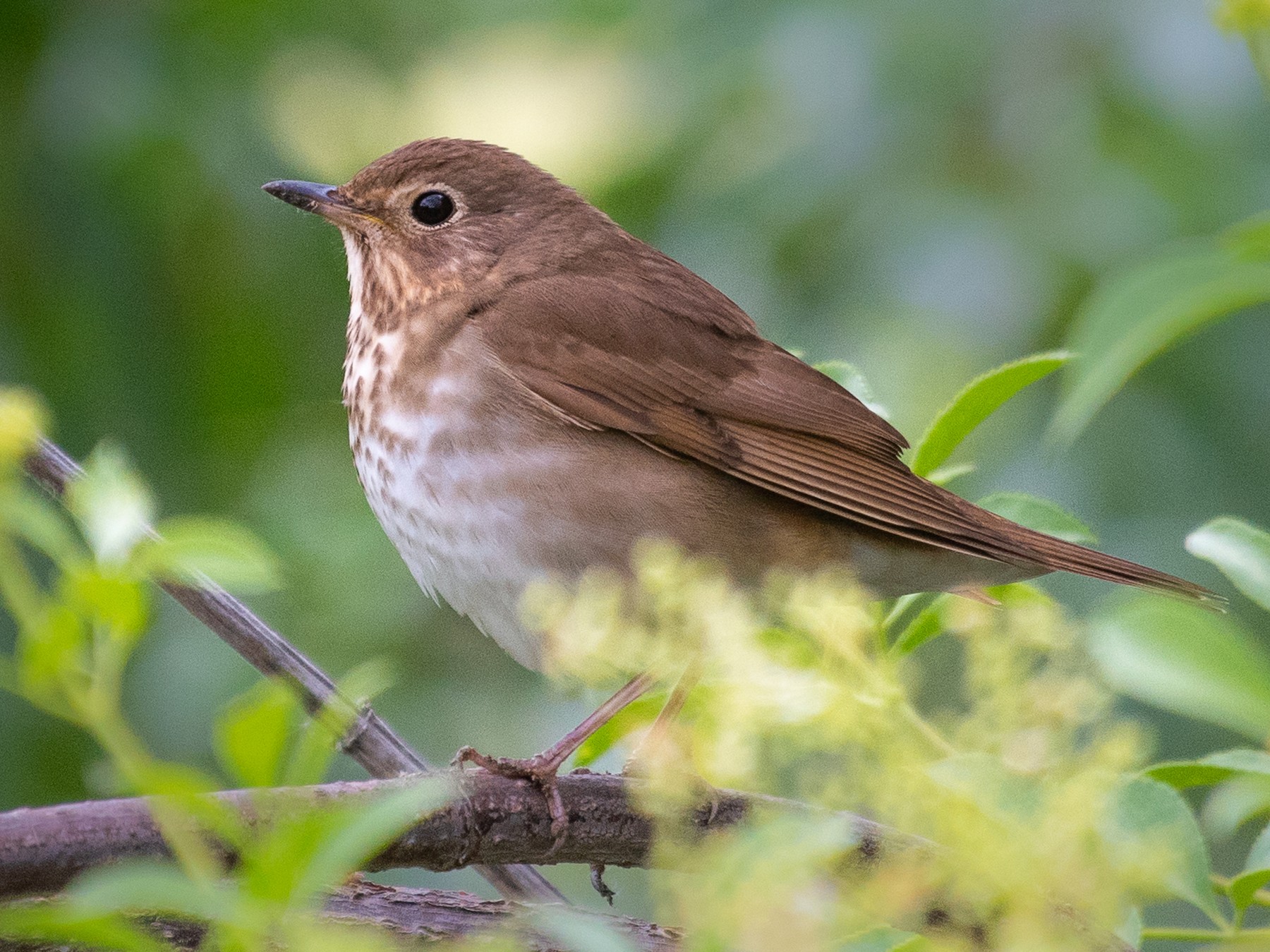
During the months of April to May and September to October, it is common to spot Swainson’s Thrushes in Alabama. They are present in approximately 5% of checklists during spring and 11% of checklists during fall.
These thrushes are medium-sized birds with pale undersides adorned with spotted chests. Their backs, on the other hand, display a brown coloration.
Scientifically known as Catharus ustulatus, Swainson’s Thrushes can be found in forested areas where they forage on the forest floor, sifting through leaf litter in search of insects during the breeding season. Additionally, they feed on red fruits such as blackberries, raspberries, huckleberries, and sumac. Ants also make up a part of their diet, and they gather other insects to feed their nestlings.
Although they are primarily seen during migration in spring and fall across the lower 48 states, Swainson’s Thrushes breed in Canada and Alaska before embarking on their journey to Central and South America for the winter.
To attract Swainson’s Thrushes to your backyard, consider providing ground-level birdbaths for them to drink from and ensuring the presence of tree and shrub cover, creating a suitable habitat for these beautiful birds.
30. Winter Wren
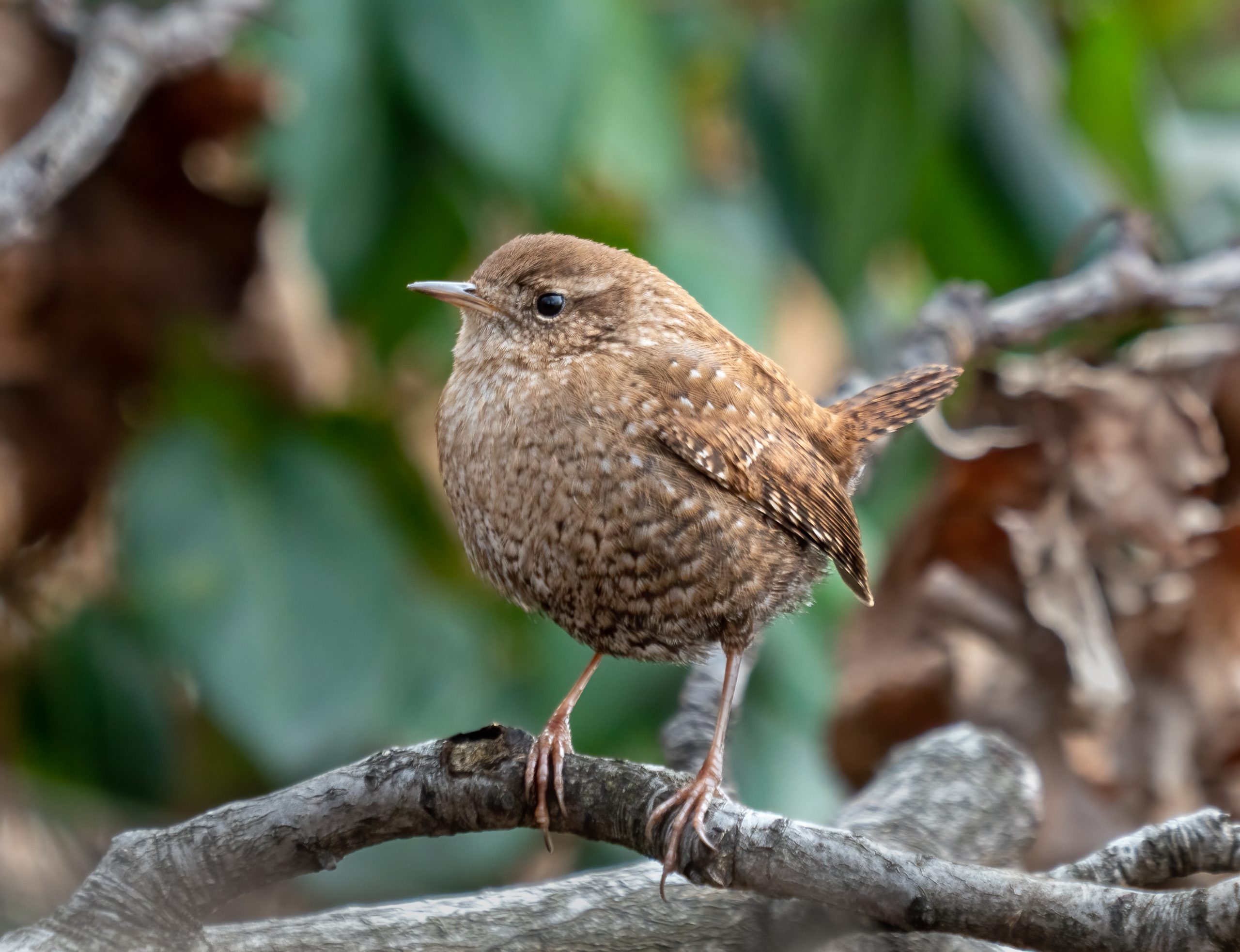
During the winter months in Alabama, it is possible to find Winter Wrens, which are observed in approximately 3% of checklists. These delightful birds typically begin arriving as early as September and some can be seen until May, with the prime months for spotting them being from October to March.
Winter Wrens are small and plump with brown feathers, featuring darker barring on their wings, tail, and belly. They possess a distinctive paler eyebrow stripe and short tails that they keep upright. Interestingly, both males and females exhibit the same appearance.
Winter Wrens bear a striking resemblance to Pacific Wrens, and in the past, they were considered to be the same species. However, they are now recognized as distinct species due to their differences in song.
Scientifically known as Troglodytes hiemalis, Winter Wrens can be found in eastern US states during the winter and in northeastern US states and Canada during the summer breeding season.
To spot Winter Wrens, one should search for them hidden in the tangled undergrowth of forests and even backyards. They have a diet consisting of insects and spiders, which they diligently search for by rummaging through fallen leaves and decaying bark.
When it comes to nesting, Winter Wrens construct round-shaped nests using twigs, moss, and grass, with a small opening. They lay 1 to 9 eggs, and the incubation period lasts around two to two and a half weeks, followed by the fledglings leaving the nest.
To attract Winter Wrens to your backyard, consider cultivating native plants and creating dense vegetation, providing an inviting environment for these charming birds.
31. Marsh Wren
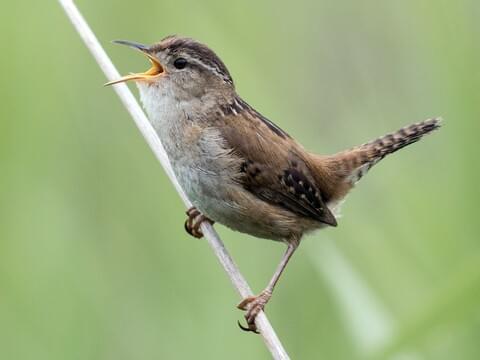
Marsh Wrens make occasional appearances in Alabama during the spring and fall migration periods, with their peak activity occurring from October to December. They can be found on approximately 3.5% of checklists during this time.
These wrens possess a brown coloration with distinct black and white streaks adorning their backs. Their underside exhibits a grayish-brown hue, and they display the characteristic upright tail commonly associated with wrens. Notably, there are no shoulder stripes present, and their bills are longer compared to Sedge Wrens.
Scientifically known as Cistothorus palustris, Marsh Wrens breed in northern US states and central Canada before embarking on migration towards southern states and Mexico. While some individuals in western regions and along the Atlantic Coast may remain year-round residents, most can be encountered during migration in the eastern US.
To locate Marsh Wrens, one should search in wetland habitats where they can be observed clinging to reeds. It’s a remarkable sight as they skillfully use each foot to grasp different stalks. While they may be challenging to spot visually, listening for their distinctive songs amongst the reeds, particularly during dawn and dusk, can aid in their detection. Marsh Wrens primarily feed on insects and spiders, which they pluck from leaves close to the water’s edge.
When constructing their nests, Marsh Wrens create fully enclosed structures with only a small opening at the top. These nests are skillfully crafted using reeds and grasses intricately woven together to form a secure abode.
32. Brown Creeper
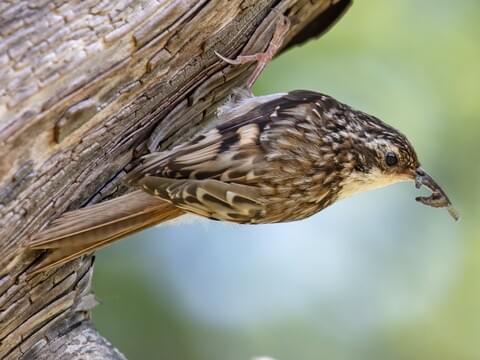
From October to April, it is possible to catch a glimpse of Brown Creepers in Alabama, with approximately 2% of winter checklists documenting their presence.
These diminutive songbirds are masters of camouflage, blending seamlessly with tree trunks due to their streaked brown backs and white undersides.
Scientifically known as Certhia americana, Brown Creepers are non-migratory, although they may shift southward or move from higher elevations during the winter months. Their range spans from Alaska and southern Canada down to northeastern and eastern US states, reaching as far as Mexico and Central America. In certain winters, they venture into central and southeastern states.
To catch sight of these elusive birds, one must carefully observe the tree trunks within mature woodlands featuring large trees. It is in these habitats that Brown Creepers forage for insects and larvae concealed beneath the bark. Notably, they ascend the tree in a distinct manner, with their bodies facing upwards, in contrast to nuthatches that traverse tree trunks in a downward orientation.
Rather than producing melodic songs, Brown Creepers emit a sharp, high-pitched call that aids in locating their whereabouts. This distinct vocalization serves as a valuable clue for detecting their presence.
33. Northern Waterthrush

Northern Waterthrushes are not commonly found in Alabama, but they make appearances during their migratory periods from March to May and August to October.
These thrush-like birds possess a larger size and share similar physical characteristics between males and females. They showcase brown heads adorned with prominent white eyebrows, dark brown backs, and white bellies intricately patterned with heavy streaking that extends from their throats to their rumps.
Scientifically known as Parkesia noveboracensis, Northern Waterthrushes breed in Canada, Alaska, and northeastern US states before embarking on their migratory journeys to Mexico, Central and South America, and the Caribbean. Some individuals may choose to remain in Central and South America throughout the year.
Dark, woody swamps, thickets, and bogs serve as favored habitats for Northern Waterthrushes. They have a propensity for areas with still or sluggish water within forests. During the winter months in tropical regions, these birds can often be found amidst mangrove habitats.
Northern Waterthrushes are adept at both aquatic and terrestrial foraging. Their long legs enable them to tread on shallow water as they search for a variety of prey, including water beetles, mosquitoes, slugs, crustaceans, snails, and occasionally small fish. Additionally, they consume caterpillars, moths, and ants, which they locate beneath leaves.
When constructing nests, Northern Waterthrushes typically select hollows or crevices near water sources. These nests may be situated within moss-covered stumps or beneath overhanging banks, often hidden among ferns for added camouflage and protection.
34. White-crowned Sparrow

White-crowned Sparrows are not commonly found in Alabama, but they make occasional appearances during winter, accounting for only 1% of checklists during this time. Their sightings typically occur from late September to mid-May, with the optimal months being November to February.
These sparrows boast a larger size, displaying a grayish plumage with long tails, small bills, and striking black and white stripes adorning their heads.
Scientifically known as Zonotrichia leucophrys, White-crowned Sparrows breed in Alaska and arctic regions of Canada before embarking on their southward migration to the lower 48 states and Mexico for winter. However, some individuals may choose to remain in coastal areas along the Pacific Coast and mountainous regions throughout the year.
White-crowned Sparrows can be found in various habitats, including weedy fields, roadsides, forest edges, and even residential yards. They primarily forage for seeds of weeds and grasses, but they also consume fruits such as elderberries and blackberries.
When it comes to nesting, White-crowned Sparrows construct their nests using twigs, grass, moss, and pine needles. These nests are typically positioned low to the ground in shrubs or, in tundra environments, on the ground itself. They lay clutches of up to seven eggs, with an incubation period of about two weeks, followed by the fledglings taking flight after approximately nine days.
To attract White-crowned Sparrows to your backyard, offering sunflower seeds as a food source can prove enticing. Additionally, they will readily feed on seeds dropped by other birds at the feeders.
Interesting tidbit: It takes an additional week or two for juvenile White-crowned Sparrows to master the art of flight once they have departed from their nests.
35. Bewick’s Wren
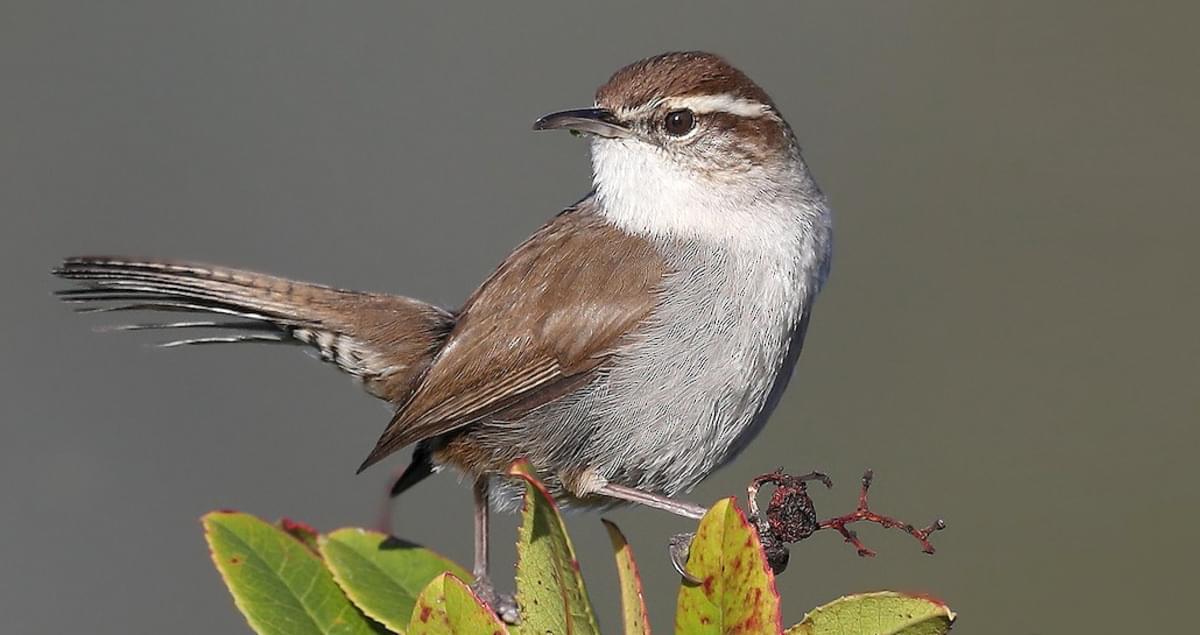
Bewick’s Wrens are considered rare sightings in Alabama, with the last recorded observation in the state dating back to 2014.
These wrens are characterized by their brown backs, long gray tails held upright with dark barring, and gray bellies with a distinct white stripe over the eye.
Thryomanes bewickii Length: 5.1 inches (13 cm) Weight: 0.3-0.4 oz (8-12 g)
Bewick’s Wrens are year-round residents in the southern and western parts of the United States, with occasional small movements during winter.
Look for Bewick’s Wrens in scrublands, thickets, and open woodlands, where they hop from branch to branch, often flicking their long tails. They primarily feed on insects and larvae such as bees, bugs, caterpillars, and beetles.
Nests of Bewick’s Wrens can be found on rock ledges, in old woodpecker nests, nest boxes, or crevices in buildings. They construct cup-shaped nests using sticks and grasses, lined with softer materials. They typically lay 3-8 eggs, which take about two weeks to hatch, and the fledging period lasts approximately two more weeks.
To attract Bewick’s Wrens to your backyard, offer suet, mealworms, and hulled sunflower seeds as part of your bird feeding setup.
36. American Tree Sparrow
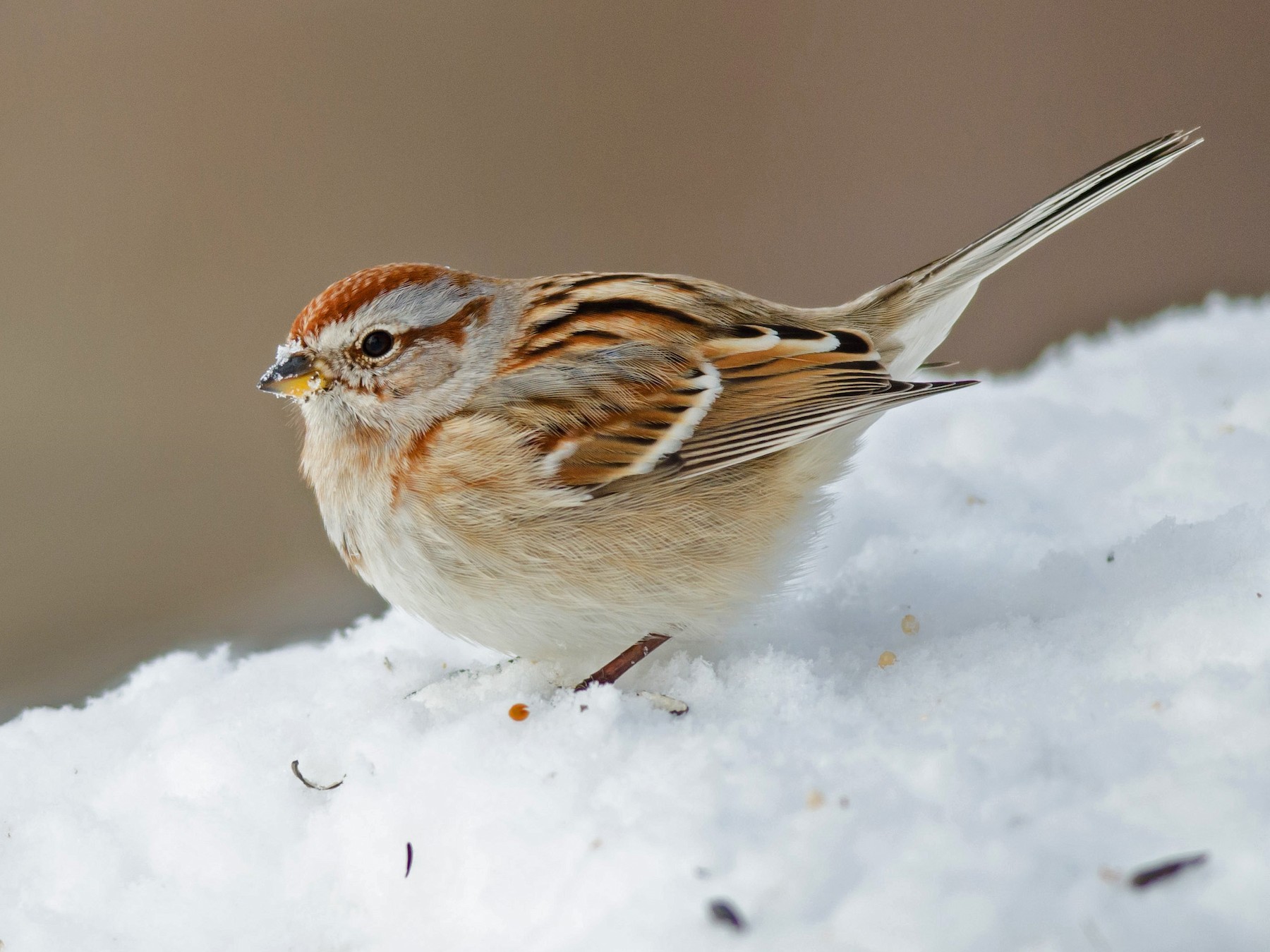
American Tree Sparrows are uncommon visitors or accidental sightings in Alabama, with the last documented observation occurring around Wheeler National Wildlife Refuge in 2020.
These sparrows have a distinctive appearance, characterized by their plump bodies, long tails, brown-streaked plumage, rusty caps, gray faces, and a noticeable rusty eye line.
Spizelloides arborea Length: 5.5 inches (14 cm) Weight: 0.5-1.0 oz (13-28 g) Wingspan: 9.4 inches (24 cm)
American Tree Sparrows are winter birds in the United States, but they breed in the far northern regions of Canada and Alaska during the summer. In winter, they migrate southward and can be found in most states across the U.S., excluding the Pacific and Gulf Coasts.
Look for American Tree Sparrows foraging in small flocks in weedy fields and beneath bird feeders, where they search for seeds and other food sources.
Nests of American Tree Sparrows are typically built on or near the ground and are constructed using twigs, grass, and moss. They lay approximately five eggs, which take just under two weeks to hatch. The young birds then spend a little over a week in the nest before fledging.
To attract American Tree Sparrows to your backyard, provide a platform feeder with a variety of food options, including black oil sunflower seeds, nyjer, cracked corn, and millet. They also readily feed on seeds that have fallen from tube feeders onto the ground.
